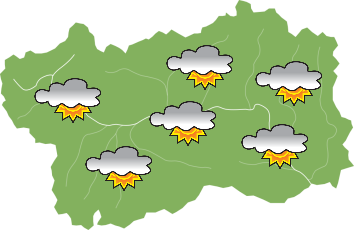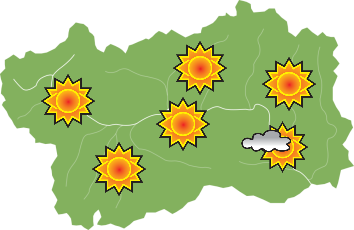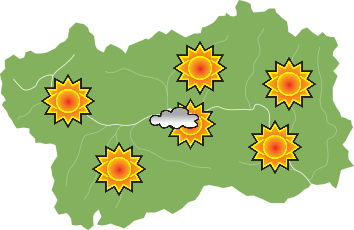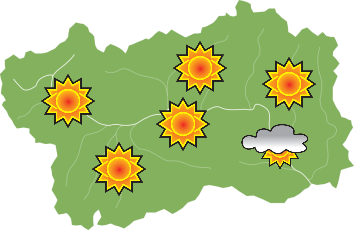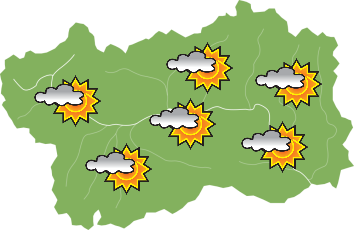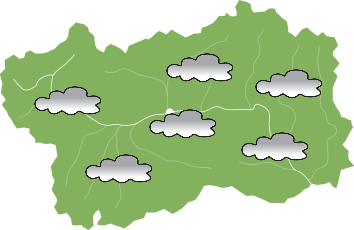The Bard fortress houses four interesting museums and hosts important temporary exhibitions and cultural events.
You can access the top of the fortress by following the pedestrian path, which runs between mighty walls starting from the interesting medieval village next to the car park, or you can use the panoramic lifts through which you can enjoy a wonderful view of the surrounding valley and the medieval village.
Remaining almost intact since its construction, the Bard fort represents one of the best examples of a barrier fortress from the early nineteenth century.
The fortress is made up of three main buildings: starting from the bottom are the Opera Ferdinando, the middle building, - Opera Vittorio - up to the top of the relief, where the Opera Carlo Alberto stands. The latter is the most imposing of the three works, which encloses within it the large quadrangular courtyard of the Piazza d'Armi, surrounded by a large portico, where the spaces dedicated to temporary exhibitions are located.
History of the Fort
Already during Theodoric’s reign (early 6th century A.D), sixty armed soldiers were garrisoned to defend the “Clausuræ Augustanæ” (a defence system set up to protect the borders of the Empire) in Bard.
In 1034, it was described as “inexpugnabile oppidum”, in one of the oldest references to a castle in Valle d’Aosta. The Savoys became the Lords of Bard in 1242, with Amadeus IV, driven by the insistence of the local inhabitants, who were tired of the abuse of power by Hugh of Bard, who exploited the position of his castle to levy heavy duties on travellers and merchants.
From that time on, the castle was always controlled by the Savoys, who held a garrison there. In 1661, the armies from other fortresses in Aosta Valley, including Verrès and Montjovet, converged in Bard.
The castle took on renewed importance with the passage of the French army in 1704 and particularly in May 1800 on the arrival of Napoleon Bonaparte, who found a garrison of 400 Austrian men within the fortress. The defence structures of the fortress were so efficient that Napoleon’s army took about two weeks to overcome the Austrian defences, eventually succeeding thanks to cunning tactics. The fortress was then dismantled by Napoleon, to avoid further problems.
The current appearance of the fort is the result of reconstruction work commissioned by Carlo Felice, at the height of the Restoration, which, from 1830 onwards, turned it into one of the largest military structures in the Aosta Valley. At the end of the 19th century the fort began to decline, first used as a penal colony and then as a weapons depot. Decommissioned in 1975 by the military, it was acquired by the Aosta Valley region in 1990 and completely renovated in 2006.
Located on the first floor of the Opera Carlo Alberto, the Museum of the Alps is an interactive space through which the visitor can travel to discover the Alpine world, exploring with the five senses a mountain experienced and transformed by the hand of man. The rooms of the exhibition route are divided into four sections, which address the mountain from a naturalistic, geographical, anthropological and meteorological point of view, involving guests of all ages, thanks to the fusion between tradition and new technologies.
Located in the Opera Vittorio, this space dedicated to kids and families brings the mountain closer through scientific workshops on climate change and its impact on glaciers. You can explore the four main peaks of the Aosta Valley – Monte Rosa, Cervino, Gran Paradiso and Mont Blanc – and compare their glacial evolution through images. The Ice Memory installation raises awareness of the health of the glaciers, explains global warming and promotes sustainable behavior.
The narrow cells where prisoners were locked up now host a historical itinerary that leads to the discovery of the history of the military site, a strategic transit point for centuries. Through films, documents and high-impact 3D reconstructions, you can discover the architectural evolution of the fortress and the historical figures who have marked its main events: from the year 1000 to its reconstruction in 1830, up to the present day.
Located in the Opera Ferdinando, on the first level of the fortress, the museum takes visitors on a journey through the evolution of defensive techniques and borders. Through models, films and authentic weapons, you can discover how fortresses have transformed from Roman times to the twentieth century. A special section invites you to reflect on the concept of frontier, offering a look at the role of the Bard Fort in the historical and geopolitical context of various eras.





